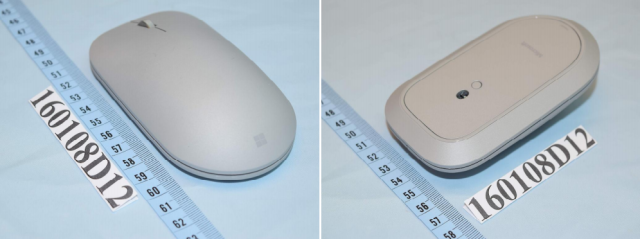
Rumors of a Surface-branded all-in-one computer continue to swirl around, and an October hardware event from Microsoft is still widely anticipated. Some new leaks have confirmed that new Surface hardware is almost surely on its way… but may not necessarily include a computer.

Yesterday, Windows Central reported a new Surface-branded Bluetooth keyboard. The keyboard looks like an updated, redesigned version of the keyboard in the Designer Bluetooth Desktoppackage: low profile, straight (non-ergonomic) design, with chiclet style keys. Windows Central also claims that a second ergonomic design is in the pipeline.
Today, thanks to the FCC, we have evidence of a new Surface-branded mouse, too. While the keyboard looks like an updated design, the mouse looks identical, save for its color, to the existing Designer Mouse. Both keyboard and mouse are in the same gray as the magnesium alloy of the Surface Book, and both are Bluetooth 4 Low Energy devices. The mouse should last an impressive 12 months on its two AAA batteries.

These similarly styled, similarly colored peripherals would seem like obvious companions for an actual Surface computer. But if it exists, it has thus far been kept successfully under wraps. MSPowerUser uncovered some patent drawings in August showing that, if nothing else, Microsoft is certainly thinking about all-in-one systems, though its approach looks quite different from the one taken by Apple. Microsoft’s filings show a few different ideas. While some diagrams show a fairly conventional all-in-one with the computer in the base (rather than behind the screen), others take a more modular approach.
The application describes a system with a screen and separate modules housing processors, memory, storage, networking, and so on. The idea is that things like more storage or new Wi-Fi support can be added just by plugging in or switching out the modules.
It all looks rather complicated, and we’d be a little surprised to see it come to fruition ahead of a more conventional design, but it does have some appeal. All-in-ones are for many a convenient form factor, but they tend to be limited in ways that can reduce their appeal. For example, while many have beautiful, large, high-resolution screens, few ship with the high-end GPUs needed to use those screens for gaming. A GPU module connected via Thunderbolt 3 could be a way to offer that computational power to those who need it, without compromising the all-in-one for those who don’t.

We’re already seeing hardware companies use Thunderbolt 3 to add bigger GPUs to laptops, so extending this system to all-in-ones isn’t completely far-fetched. But with all-in-ones prized in part for their simplicity, adding this kind of modularity could well be a step in the wrong direction.
While we’ve heard nothing lately from Redmond about new hardware, the word on the street is still that Microsoft will be launching something later this month. It’s certainly about time that Microsoft released something new in the Surface line; with Kaby Lake hardware hitting the streets, the Surface Pro 4 and Surface Book are arguably in need of a refresh to give users battery life gains. Either way, we’d expect to hear about any potential events soon.
[Source:-ARS Technica]




